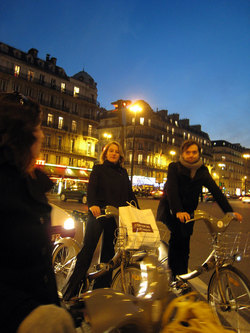
As any of my friends will confirm, I’m pretty much obsessed with Vélib, the public bike-sharing system here in Paris that makes it super-convenient to zip around the city on two wheels. It also gets my geek on: Vélib is a complex system that neatly tucks away its complexity behind a simple interface and some clever behavioral incentives.
Here’s how Vélib works: There are over 20,000 bikes distributed among 1,500 stations throughout the city. Pick up a bike from one station, return it to another. You purchase a daily, weekly or annual subscription, which allows you to ride the bike as much as you like in 30-minute chunks. The bikes aren’t for leisure rentals; they’re intended to be used for quick, direct one-way trips of 30 minutes. You have to pay for longer trips, and overage fees add up quickly.
As you might expect, these one-way trips are not evenly distributed throughout the city at certain hours. Bikes tend to clump in some areas and empty out in others. To address this, workers circulate in trucks, moving the bikes from full stations to empty ones.
It turns out that this is an uphill battle. Literally.
See, Paris has a handful of steep hills. The Montmartre neighborhood, for example, is perched at the top of a rise some 450 feet above the Seine. Taking a bike down the hill has a certain obvious appeal, but riding back up to the top… not so much.
The uphill penalty is financial as well as physical. The hills are at the outer edges of the city, so the extra time to get up a hill for trips from the city center can easily nudge you over the 30-minute free period. It can cost money to ride a Vélib bike up the hill. The result: In Vélib’s first year of service, bike stations in Montmartre were always empty. The brute-force method of moving bikes by truck couldn’t keep up.
Over the summer, though, the good people of Vélib added a simple behavioral incentive to the system: Return your bike to one of 100 stations perched over 60 meters above the rest of the city, and 15 minutes of free riding is added to your account.

They turned a hassle into a game, pain into points. Riding uphill is now a power-up. The free minutes are a bonafide reward, too, saving money on destinations that are often outside of the free 30-minute radius. More bikes make it back up the hill. Since the program was launched in June, over nine years of bonus minutes have been awarded.
As a software developer, I obsess over performance bottlenecks, inefficient areas of code that bog down the rest of the application. It turns out that the best solution often isn’t a brute-force route through the problem (“let’s truck the bikes up the hill”) but rather an elegant sidestep around the issue (“how can we get the riders to do it instead?”).
So the systems guy in me loves this solution, but even more, it appeals to something more playful. I love that this simple tweak made an uphill commute feel more like a game, where you earn points and reward for your effort. It reminds me of Jane McGonigal’s spirited encouragement to do more to “make the real world more like games,” which I wrote about a few months ago:
Her idea: By introducing game-like systems into our work and home lives, we can imbue otherwise tedious tasks with the spirit of reward and collaboration that makes gameplay fun. Jane pointed to a game called Chore Wars which turns housework into gameplay for families. (“Finally you can get experience points for housework!”) She also pointed to the Nike+iPod gizmo that transforms running into a community video game.
Vélib fixed a performance bottleneck by introducing a game into the system. What’s not to love?





